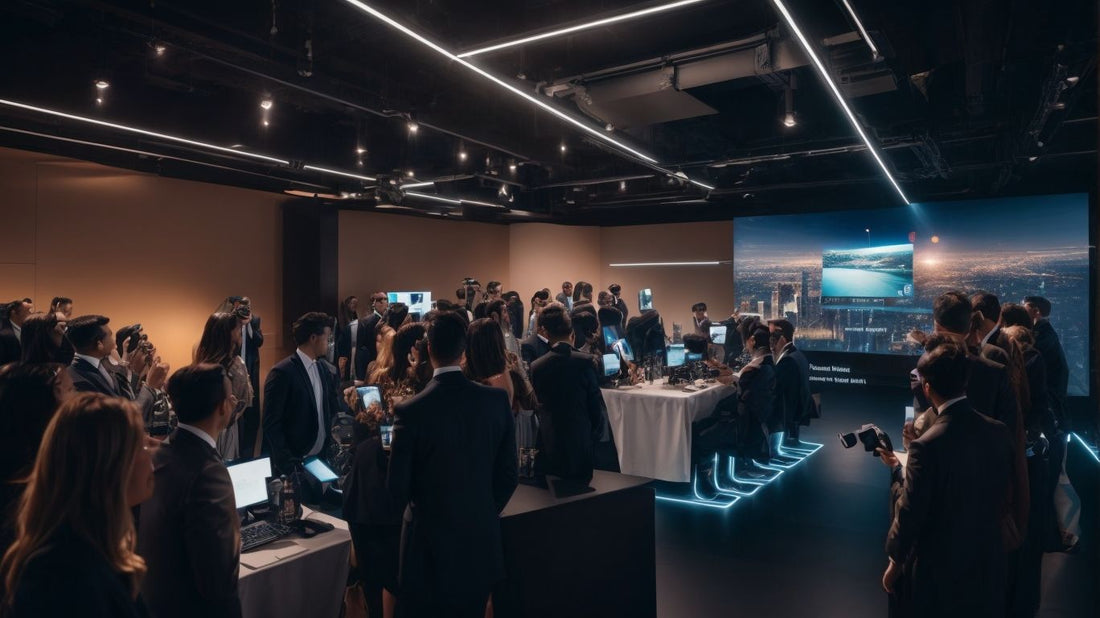
The Ultimate Guide to Virtual Corporate Events: Innovative Solutions for Remote Team Building and Engagement
Share
.jpg)
Virtual corporate events have gained significant popularity in recent times, offering a unique and innovative approach to business gatherings. These events bring together professionals from different locations and enable them to participate in conferences, workshops, trade shows, and team-building activities virtually. In this technology-driven era, virtual corporate events have become increasingly important, offering numerous advantages over traditional in-person events.
When it comes to virtual corporate events, there are various types to choose from, including virtual conferences, webinars, virtual trade shows, and virtual team-building activities. Each type caters to different objectives and requirements of businesses.
However, planning and executing virtual corporate events come with their own set of challenges. From technical difficulties to engaging attendees and facilitating networking opportunities, event organizers must be equipped with the right strategies and solutions.
To ensure a successful virtual corporate event, best practices must be followed. This includes clear communication, interactive sessions, and utilizing technology tools and features for enhanced attendee experience.
The future of virtual corporate events looks promising, with emerging trends like hybrid events that combine both virtual and in-person elements, as well as enhanced virtual reality and immersive experiences.
What Are Virtual Corporate Events?
What Are Virtual Corporate Events?
Virtual corporate events are online gatherings organized by businesses to engage employees, clients, or partners. These events, which are called virtual corporate events, are designed to mimic traditional in-person conferences, meetings, or team-building activities but are conducted in a virtual environment. Attendees can participate from anywhere using a computer or mobile device.
Virtual corporate events provide a platform to network, share information, collaborate on projects, and strengthen relationships. Some examples of virtual corporate events include virtual conferences, webinars, virtual trade shows, and virtual team-building activities. These events offer convenience, cost-effectiveness, and the ability to reach a larger audience.
By embracing technology, businesses can adapt to changing circumstances while still achieving their goals and objectives through virtual corporate events.
Why Are Virtual Corporate Events Important?
Virtual corporate events have become increasingly important in today's digital landscape. They offer numerous benefits that can't be ignored. From cost-effectiveness to increased attendance and flexibility, these events revolutionize the way companies engage with their audience. With virtual platforms, businesses can save a significant amount of money while reaching a wider audience. The flexibility and accessibility of virtual events empower participants to join from anywhere in the world. In this section, we'll delve into the key reasons why virtual corporate events have gained immense significance.1. Cost-Effectiveness
Virtual corporate events are important for several reasons, including their cost-effectiveness. Here are some points to consider:
- Cost savings: Virtual events eliminate travel and accommodation expenses, venue rental fees, and catering costs.
- Reduced planning time: Organizing a virtual event requires less time for logistical considerations.
- Wider reach: Virtual events have the potential to attract a larger audience since participants can join from anywhere in the world.
- Enhanced analytics: Virtual platforms offer data and analytics tools that provide valuable insights into attendee engagement and behavior.
- Customization options: Virtual events can be tailored to fit various budgets and specific needs.
By opting for virtual corporate events, companies can allocate their resources more efficiently and still deliver impactful experiences.
2. Increased Attendance
Increased attendance is one of the key advantages of virtual corporate events. By eliminating the need for physical travel and accommodation, virtual events have the potential to attract a larger audience. Here are some reasons why virtual events can lead to increased attendance:
- Convenience: Attendees can join from anywhere in the world, eliminating geographical limitations and allowing for broader participation.
- Cost savings: Virtual events are typically more affordable, making it easier for attendees to participate without incurring travel expenses.
- Flexibility: Virtual events offer flexible scheduling, allowing attendees to join sessions at their convenience, increasing the likelihood of attendance.
- Accessibility: Virtual events are accessible to individuals with disabilities, ensuring inclusivity and reaching a wider range of participants.
Fact: According to a survey, virtual events have witnessed a 30-40% increase in attendance compared to in-person events.
3. Flexibility and Accessibility
Flexibility and accessibility are the key advantages of virtual corporate events, offering convenience and inclusivity for all participants. There are several ways in which virtual events showcase and embody flexibility and accessibility:
- Location Independence: Virtual events empower attendees to join from any corner of the globe, eliminating the need for travel and reducing associated time and costs.
- Time Flexibility: With virtual events, participants have the choice to access on-demand or recorded sessions, allowing them to engage with the content at their own convenience.
- Accessible Features: Virtual platforms can incorporate closed captioning, language translation, and screen reading software, ensuring that individuals with disabilities can fully participate.
- Increased Reach: The virtual nature of events removes geographical boundaries, enabling a broader audience to be reached, leading to more diverse participation.
- Flexible Scheduling: Since virtual events cater to participants across various time zones, they provide the freedom to schedule sessions or meetings with increased flexibility.
Types of Virtual Corporate Events
Looking for engaging ways to connect with your team? Look no further! In this section, we'll explore the exciting world of virtual corporate events. From virtual conferences and webinars to virtual trade shows and team building activities, get ready to discover the diverse range of opportunities that await. So get your screen time ready, because we're about to dive into the different types of virtual corporate events that will revolutionize the way your team collaborates and engages in the digital age.1. Virtual Conferences
Virtual conferences have become increasingly popular due to their convenience and accessibility. Here are some key points to consider:
- Flexibility: Attendees can participate from anywhere in the world, eliminating the need for travel expenses or time away from the office.
- Cost-effectiveness: Virtual conferences, like Virtual Conferences, are often more affordable than in-person events, saving on venue rental and catering costs.
- Increased reach: By removing geographical limitations, Virtual Conferences can attract a larger audience and increase participation.
- Engagement: Interactive features like live Q&A sessions, chat rooms, and virtual networking opportunities enhance attendee engagement in Virtual Conferences.
- Content delivery: Speakers can present using multimedia tools, providing a more dynamic and engaging experience for attendees at Virtual Conference sessions.
- Tracking and analytics: Virtual platforms offer insights into attendee behavior, allowing organizers to measure the success of Virtual Conference sessions and gather useful data.
2. Webinars and Online Workshops
- Virtual corporate events, including webinars and online workshops, offer numerous benefits for businesses, such as cost-effectiveness, increased attendance, and flexibility.
- Planning and executing successful webinars and online workshops require careful preparation and consideration.
- To have a successful virtual corporate event, follow these steps:
- Define your objectives and goals for the webinar or online workshop.
- Select a reliable virtual event platform that supports your desired features and functionalities.
- Create engaging content and activities that cater to your target audience.
- Conduct thorough testing and ensure technical setup is seamless.
- By following these steps, businesses can overcome challenges like technical difficulties, lack of audience engagement, and networking limitations.
- Employing best practices, such as clear communication, interactive sessions, and utilizing technology tools, will help ensure a successful webinar or online workshop.
- Virtual corporate events are constantly evolving, with the future potentially bringing hybrid events and enhanced virtual reality experiences.
3. Virtual Trade Shows and Expos
Virtual Trade Shows and Expos have gained significant popularity in the corporate world, providing numerous advantages for both businesses and attendees. Here are several key reasons why Virtual Trade Shows and Expos hold great importance:
4. Virtual Team Building Activities
Virtual team building activities are crucial for fostering collaboration, engagement, and morale among remote teams. These activities help team members build relationships, improve communication, and strengthen their bond. Here are some virtual team building activities:
- Online icebreaker games to break the ice and build connections.
- Virtual escape rooms to encourage problem-solving and teamwork.
- Virtual trivia or quiz competitions for friendly competition and knowledge-sharing.
- Virtual team building challenges or scavenger hunts to promote collaboration and creativity.
- Virtual team-building workshops or training sessions to enhance skills and promote learning.
- Virtual happy hours or social events, such as virtual cooking classes or virtual talent shows, to boost team spirit and create a sense of fun.
Remember to choose activities that align with your team's interests, goals, and preferences. Regularly schedule these virtual team building activities to keep team members engaged and connected. With virtual team building activities, you can foster a positive remote work culture and enhance team dynamics.
Planning and Execution of Virtual Corporate Events
Planning and executing virtual corporate events require careful consideration and strategic decision-making. In this section, we will uncover the key steps involved in crafting successful virtual gatherings. From defining event goals and selecting the ideal virtual platform to designing captivating content and conducting thorough testing, we will navigate through the essentials of organizing virtual corporate events. So, join us on this journey as we explore the ins and outs of creating memorable online experiences for businesses and their attendees.1. Determining Event Goals and Objectives
Determining event goals and objectives is a crucial step in planning virtual corporate events. It involves identifying the purpose of the event and what you hope to achieve. The goals and objectives should align with the overall objectives of the company or organization. This process helps in setting clear expectations and defining success criteria. Some examples of event goals and objectives could be increasing brand awareness, promoting a new product or service, fostering customer engagement, or generating leads. By determining event goals and objectives, you can tailor the event content, activities, and communication strategies to achieve the desired outcomes.
2. Selecting the Right Virtual Event Platform
- When it comes to selecting the right virtual event platform, there are a few crucial steps to consider:
- First, identify your event requirements and objectives. This will help you determine the specific features and functionalities you need from a platform.
- Next, take the time to research and compare different virtual event platforms. Look at their capabilities, user interface, and ease of navigation.
- Consider the scalability and flexibility of each platform. You want to make sure it can accommodate the size and needs of your event.
- Also, look for customization options. It's important to be able to tailor the platform to your brand and event theme.
- Another important factor to consider is the technical support and customer service offered by the platform provider.
By following these steps, you can make an informed decision. This will help you select the right virtual event platform that aligns with your event goals. It will also provide a seamless and engaging experience for all attendees.
3. Designing Engaging Content and Activities
Designing engaging content and activities for virtual corporate events is crucial to keep participants interested and involved. To create a captivating experience, incorporate interactive elements that encourage active participation. Polls, quizzes, and Q&A sessions can be included in interactive presentations. Additionally, virtual breakout rooms can be utilized to divide participants into smaller groups for discussions and networking opportunities. By introducing gamification, such as games, challenges, or competitions, collaboration and enthusiasm can be promoted among attendees. Live demonstrations, such as product demos or interactive workshops, provide hands-on learning experiences. Virtual networking can be facilitated through virtual meet-ups, one-on-one chats, or speed networking sessions. Remember to tailor these activities according to the event's objectives and ensure the content remains relevant and engaging. Developing interactive and dynamic content will help create a memorable virtual corporate event experience for participants.
4. Testing and Technical Setup
Incorporating testing and technical setup is an essential step in the planning and execution of virtual corporate events. It plays a pivotal role in ensuring the smooth running of the event and minimizing technical difficulties. The testing phase revolves around checking the audio and video quality, internet connectivity, and compatibility of the virtual event platform with various devices. Additionally, the technical setup involves arranging the necessary equipment and ensuring that participants have access to the required tools and software. By conducting thorough testing and implementing proper technical setup, one can contribute to a seamless and successful virtual corporate event.
Here are some suggestions to enhance testing and technical setup:
- Prioritize conducting comprehensive testing before the event to identify and resolve any potential technical issues.
- Provide participants with clear instructions regarding the necessary equipment and software.
- Offer dedicated technical support during the event to promptly troubleshoot any arising issues.
Challenges and Solutions for Virtual Corporate Events
Virtual corporate events have revolutionized the way businesses connect and engage, but they come with their fair share of challenges. From technical difficulties and connectivity issues to lack of audience engagement and networking challenges, these hurdles can hinder the success of such events. In this section, we will uncover effective solutions to conquer these obstacles and ensure seamless virtual experiences. So, get ready to discover how to overcome the technical woes, boost audience participation, and foster meaningful connections in the realm of virtual corporate events.1. Technical Difficulties and Connectivity Issues
Technical difficulties and connectivity issues are common challenges faced during virtual corporate events. These issues, including technical disruptions and internet outages, can disrupt the flow of the event and hinder participant engagement. To overcome these challenges, event planners should ensure reliable internet connections, conduct thorough technical testing beforehand, and have backup plans in case of any disruptions. Providing clear instructions to participants on how to access the event platform and troubleshoot common technical issues can help minimize these difficulties. By addressing technical concerns effectively, virtual corporate events can run smoothly and provide a seamless experience for attendees.
During a virtual corporate event, a keynote speaker experienced a sudden internet outage just minutes before their scheduled presentation. The event organizers quickly reacted by introducing a pre-recorded version of the speaker's presentation while resolving the connectivity issue. This seamless transition allowed the audience to continue watching the session uninterrupted despite the technical difficulties and connectivity issues. The organizers kept the attendees informed about the situation and held a live Q&A session with the speaker once the connectivity was restored. This incident highlighted the importance of preparedness and quick problem-solving in overcoming technical difficulties and connectivity issues during virtual events.
2. Lack of Audience Engagement
Lack of audience engagement in virtual corporate events is a common challenge that event organizers frequently encounter. To effectively address this issue, event planners have the opportunity to incorporate a range of interactive features into their events. Live polls, chat rooms, and Q&A sessions are just a few examples of the engaging elements that can be implemented to encourage active participation. Additionally, integrating gamification components such as quizzes or competitions can significantly enhance audience engagement. Furthermore, by providing attendees with pre-event materials and encouraging them to prepare in advance, organizers can generate interest and encourage active involvement. To foster connections and promote engagement, breakout rooms can be utilized for smaller group discussions and networking sessions. These strategies can effectively combat the challenge of lack of audience engagement, resulting in more interactive and successful virtual corporate events.
In the mid-1800s, the task of maintaining audience engagement posed a significant challenge for theatrical performances. This obstacle prompted the development of interactive theater experiences, including melodrama and vaudeville shows, where audience participation was actively encouraged. These innovative forms of entertainment revolutionized the industry and paved the way for modern interactive experiences. Similarly, in the digital age, the issue of lack of audience engagement in virtual events is being tackled through the utilization of cutting-edge technologies and captivating formats.
3. Networking Challenges
Networking Challenges can arise when organizing virtual corporate events. The lack of face-to-face interaction makes it difficult for attendees to connect and build relationships. There are solutions to overcome these challenges. Organizers can implement virtual networking sessions where participants can engage and interact with each other through chat features, breakout rooms, or online forums. They can also provide networking opportunities before and after the event, allowing attendees to connect and arrange virtual meetings. Incorporating icebreaker activities and group discussions can encourage networking and collaboration among participants. These measures help to create a sense of community and foster meaningful connections in virtual corporate events.
Best Practices for Successful Virtual Corporate Events
Planning a virtual corporate event? Keep reading for the best practices that will ensure its success! We'll explore key elements that make a difference, such as clear communication and instructions, interactive and engaging sessions, and the effective utilization of technology tools and features. Get ready to deliver an unforgettable virtual experience that will leave your participants inspired and connected.1. Clear Communication and Instructions
Clear communication and instructions are crucial for the success of virtual corporate events. To ensure effective communication, follow these steps:
- Establish clear event goals and objectives that will guide your communication strategy.
- Create a detailed agenda and share it with all participants well in advance.
- Choose a user-friendly virtual event platform that offers seamless communication for organizers, presenters, and attendees.
- Provide precise instructions on how to access and navigate the virtual event platform.
- Employ a combination of written and visual cues to effectively convey information.
- Assign a dedicated person or team to address technical glitches and offer assistance during the event.
- Promote active participation by incorporating interactive elements like polls, Q&A sessions, and chat features.
- Ensure that presenters and speakers are well-prepared and have clear instructions regarding their roles and time limits.
- Send post-event follow-up communications to gather feedback and address any pending questions or concerns.
2. Interactive and Engaging Sessions
- Interactive and engaging sessions are crucial for the success of virtual corporate events. Here are some strategies to make your sessions more interactive:
- Utilize polling and surveys to gather real-time feedback and opinions from participants in order to create interactive and engaging sessions.
- Incorporate interactive elements like quizzes or challenges to keep attendees actively engaged during the sessions.
- Encourage active participation through Q&A sessions, live chats, or breakout rooms for discussions to ensure interactive and engaging sessions.
- Include interactive presentations with multimedia elements like videos, animations, and interactive slides to make the sessions more engaging.
- Organize virtual networking activities, such as virtual coffee breaks or speed networking sessions, to facilitate connections between attendees and create interactive and engaging sessions.
3. Utilizing Technology Tools and Features
Utilizing technology tools and features is crucial for successful virtual corporate events. Here are some key ways to leverage technology:
- Virtual Event Platforms: Choose a platform with robust features like live streaming, chat, polls, and Q&A sessions.
- Interactive Presentations: Utilize tools like interactive slides, virtual whiteboards, and breakout rooms to engage participants.
- Networking Tools: Incorporate networking features, such as virtual lounges or one-on-one chat rooms, to facilitate connections.
- Streaming and Recording: Ensure smooth streaming for remote attendees and provide recorded sessions for on-demand viewing.
- Data Analytics: Utilize analytics tools to track participant engagement, attendance rates, and feedback for event improvement.
By effectively utilizing these tools and features, virtual corporate events can be engaging and impactful experiences.
Future of Virtual Corporate Events
Virtual corporate events have taken the business world by storm, but what does the future hold for this rapidly evolving landscape? In this section, we delve into the exciting advancements that lie ahead. From the emergence of hybrid events, combining the best of both virtual and in-person experiences, to the tantalizing opportunities presented by enhanced virtual reality and immersive experiences, we explore the cutting-edge possibilities that will shape the future of corporate events. Get ready to be astounded by the next level of innovation in the corporate event industry!1. Hybrid Events
Hybrid events, the innovative combination of virtual and in-person elements, have emerged as a crucial trend in the future of corporate events. These events offer a plethora of benefits and advantages.
- Increased reach: Hybrid events transcend physical limitations, empowering attendees from all corners of the world to participate online and enrich the experience.
- Flexibility: Choosing between attending in person or virtually, attendees can now accommodate their preferences, schedules, and even travel restrictions.
- Cost-effectiveness: With hybrid events, you can significantly reduce expenses associated with venue rentals, travel, and accommodation, while still ensuring an immersive and engaging experience for all.
- Enhanced engagement: The online component of hybrid events presents exciting interactive features like live Q&A sessions and virtual networking. This boosts engagement and encourages active participation.
- Data and analytics: Hybrid events provide invaluable insights into participant demographics, engagement levels, and attendee feedback. Armed with this data, event evaluation and decision-making become more informed and effective.
2. Enhanced Virtual Reality and Immersive Experiences
Enhanced virtual reality and immersive experiences have gained significant importance in the world of virtual corporate events. By leveraging cutting-edge technology, companies can create interactive and captivating environments for their participants. Through the use of virtual reality headsets or immersive platforms, attendees can feel as if they are physically present in a conference, workshop, or trade show. This enhances the overall event experience, increases engagement, and facilitates more meaningful interactions. The future of virtual corporate events relies on the continuous advancement of these immersive technologies, enabling even more lifelike and impactful experiences for participants.
The concept of virtual reality can be traced back to the 1930s when science fiction writer Stanley G. Weinbaum wrote a short story featuring a pair of goggles that allowed individuals to immerse themselves in a fictional world. However, it wasn't until the late 1980s and early 1990s that virtual reality started to become feasible with the development of head-mounted displays and motion-tracking systems. Today, virtual reality has revolutionized various industries, such as entertainment, healthcare, and education, completely transforming the way we perceive and engage with digital content.
Frequently Asked Questions
FAQs about Virtual Corporate Events
1. How can virtual corporate events connect colleagues online?
Virtual corporate events provide interactive digital spaces where colleagues can participate in activities and games together. These events promote interaction and allow colleagues to connect and bond, even when they are working remotely.
2. Why are virtual social events important for human well-being?
Virtual social events, such as online team building activities and virtual entertainment, are important for human well-being because social time with others is a key predictor of well-being. These events provide opportunities for colleagues to have fun, experience joy, and improve team morale.
3. Can virtual corporate events be inclusive for remote workers?
Yes, virtual corporate events can be inclusive for remote workers. With the use of video platforms and virtual event interactions, remote workers can actively participate in the event activities and feel included in the team gatherings.
4. What are some creative virtual corporate event ideas?
Some creative virtual corporate event ideas include virtual murder mysteries, virtual holiday events, virtual escape rooms, virtual wine tastings, virtual dance parties, and virtual arts & craft activities. These events provide fun and inclusive experiences for colleagues.
5. How can I book virtual corporate events with Kapow! Events Management?
To book virtual corporate events with Kapow! Events Management, you can visit their website and explore the services they offer. You can also find contact details on the website to get in touch with Kapow! for further assistance in the booking process.
6. Are team building kits available for virtual corporate events?
Yes, team building kits are available for virtual corporate events. Companies like KraftyLab offer virtual team building events, activities, games, and wellness services. These kits provide all the necessary materials for team building activities to be conducted online.






